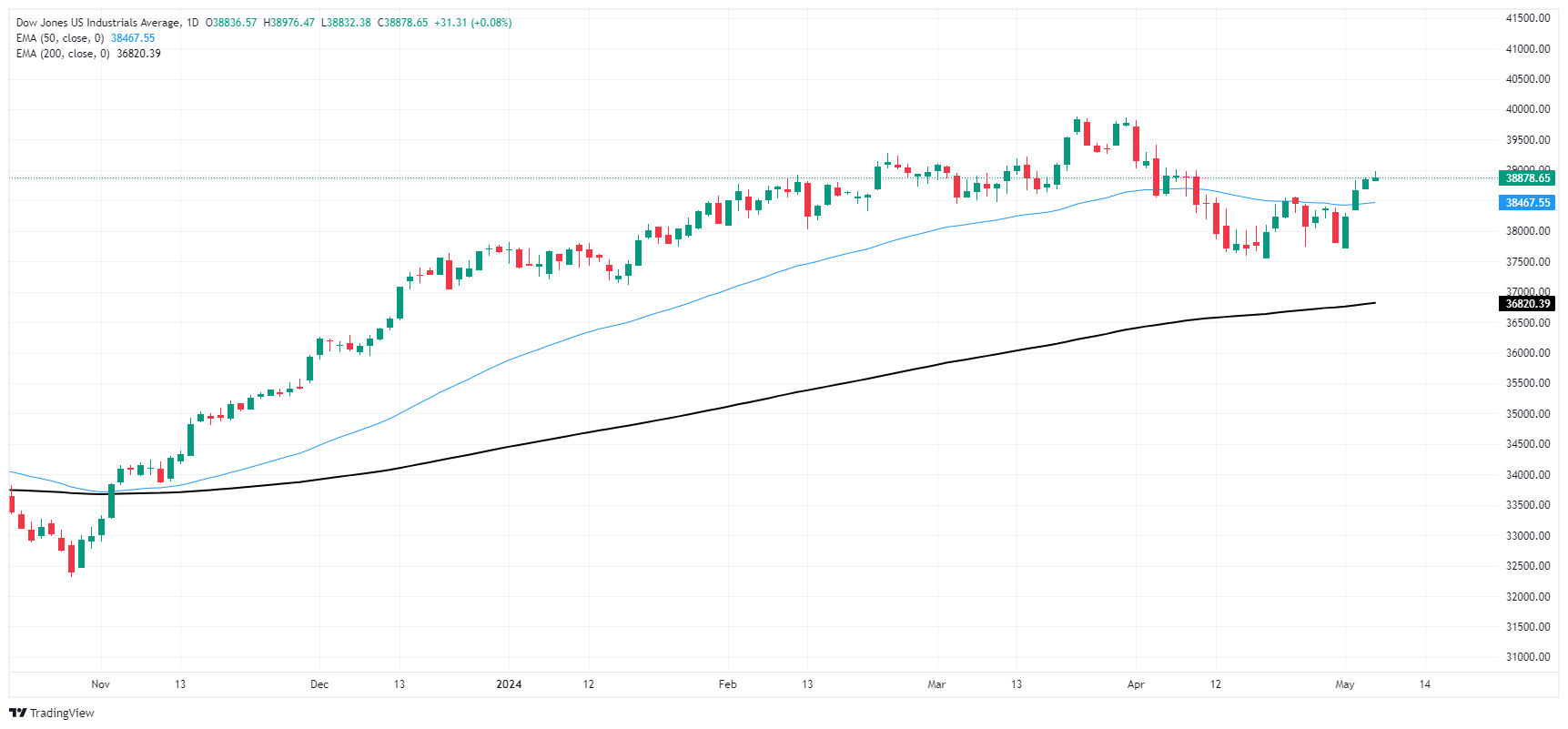Dow Jones struggles to find gains as Fedspeak trips up rate cut hopes

- Dow Jones softly higher on Tuesday but risk appetite remains tepid.
- Fed officials throw caution about broad-market rate cut hopes.
- Rate markets still see nearly 70% odds of a September rate trim.
The Dow Jones Industrial Average (DJIA) found thin gains on Tuesday, climbing around a tenth of a percent through the American market session. Still, broad-market risk appetite is being threatened by cautionary statements from Federal Reserve (Fed) officials highlighting the Fed’s lack of capacity to slash rates if inflation pressures and labor market tightness don’t show firmer signs of slackening.
Fed’s Kashkari: Rate hikes unlikely, but not entirely off the table
The Dow Jones gained a slim margin in early Tuesday trading, climbing a tenth of a percent but getting hung up on statements from Minneapolis Fed President Neel Kashkari, who noted that progress on bringing down inflation looks to have stalled. Kashkari also noted that the Fed will need to see progress on inflation and easing pressure in the US’ tight labor market before rate cuts can be fully considered, noting that the Fed is increasingly likely to hold rates where they are for much longer than the public expects.
According to the CME’s FedWatch Tool, rate markets still expect the Fed to deliver a first quarter-point rate cut at the September meeting. Rate traders see 67% odds of a September 25-basis-point cut, with over 90% odds that the Fed will deliver a second cut before the end of 2024.
Dow Jones news
Despite hawkish warning shots from Fed officials, most of the Dow Jones equities were in the green on Tuesday. Merck & Co Inc. (MRK) broke late in the day to climb 2.2%, closing at $130.38 per share. Merck & Co is rising after the pharmaceutical company’s latest drug offering, KEYTRUDA, significantly outperformed placebo trials in combating unique forms of cancer.
On the downside, Walt Disney Co. (DIS) tumbled nearly -10% on the day, falling -11 points and declining to $105.39 per share after Disney reported a wide downside miss in membership growth in their subscription streaming offerings.
Dow Jones technical outlook
The Dow Jones clipped into an intraday high near 38,980.00 on Tuesday before slipping back to flounder at the 38,900.00 handle. The major equity index is still trading into the bullish side, but struggling to make decisive gains above the day’s opening bids near 38,880.00.
The Dow Jones is trading well into bullish territory on daily candles, holding above long-term technical support from the 200-day Exponential Moving Average (EMA) near 36,842.67. The DJIA is on pace to close in the green for a fourth consecutive trading day, and remains well-bid above the last swing low into 37,600.00.
Dow Jones five-minute chart
Dow Jones daily chart
Dow Jones FAQs
The Dow Jones Industrial Average, one of the oldest stock market indices in the world, is compiled of the 30 most traded stocks in the US. The index is price-weighted rather than weighted by capitalization. It is calculated by summing the prices of the constituent stocks and dividing them by a factor, currently 0.152. The index was founded by Charles Dow, who also founded the Wall Street Journal. In later years it has been criticized for not being broadly representative enough because it only tracks 30 conglomerates, unlike broader indices such as the S&P 500.
Many different factors drive the Dow Jones Industrial Average (DJIA). The aggregate performance of the component companies revealed in quarterly company earnings reports is the main one. US and global macroeconomic data also contributes as it impacts on investor sentiment. The level of interest rates, set by the Federal Reserve (Fed), also influences the DJIA as it affects the cost of credit, on which many corporations are heavily reliant. Therefore, inflation can be a major driver as well as other metrics which impact the Fed decisions.
Dow Theory is a method for identifying the primary trend of the stock market developed by Charles Dow. A key step is to compare the direction of the Dow Jones Industrial Average (DJIA) and the Dow Jones Transportation Average (DJTA) and only follow trends where both are moving in the same direction. Volume is a confirmatory criteria. The theory uses elements of peak and trough analysis. Dow’s theory posits three trend phases: accumulation, when smart money starts buying or selling; public participation, when the wider public joins in; and distribution, when the smart money exits.
There are a number of ways to trade the DJIA. One is to use ETFs which allow investors to trade the DJIA as a single security, rather than having to buy shares in all 30 constituent companies. A leading example is the SPDR Dow Jones Industrial Average ETF (DIA). DJIA futures contracts enable traders to speculate on the future value of the index and Options provide the right, but not the obligation, to buy or sell the index at a predetermined price in the future. Mutual funds enable investors to buy a share of a diversified portfolio of DJIA stocks thus providing exposure to the overall index.
